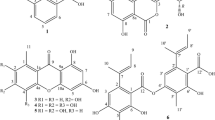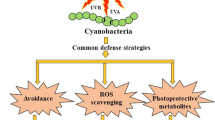Abstract
Enodolichenic fungi (ELF) are considered a promising bio-resource since they produce a variety of novel secondary metabolites with bioactivities. Ultraviolet (UV) radiation in sunlight containing UVA and UVB can cause acute and chronic skin diseases, and the demand for UV protectants in sunscreens has been increasing. Such situations evoke the strong interest of researchers in seeking effective UV protectants from natural products. In this study, we obtained partially purified 7-hydroxy-2-octenoic acid-ethyl ester (7E) from the secondary metabolites of ELF000548, which has UVA absorption activity. The antioxidant properties were performed by in vitro tests. The superoxide anion scavenging activity and inhibition of linoleic acid peroxidation of the 7E mixture were higher than ascorbic acid (ASA) and butyl hydroxyl anisole (BHA). Furthermore, the compound recovered the damage caused by UVB irradiation and inhibited melanin synthesis. Additionally, the 7E mixture exhibited no cytotoxicity toward the mouse melanoma cell lines, B16F1 and B16F10, except for the normal cell line, HaCaT. In general, these results are the first report about bioactivities of 7E, and those demonstrated that this compound might be a UV protectant to go further study.






Similar content being viewed by others
References
Adhoute H, De Rigal J, Marchand J, Privat Y, Leveque J (1992) Influence of age and sun exposure on the biophysical properties of the human skin: an in vivo study. Photodermatol Photoimmunol Photomed 9(3):99–103
Arnold AE, Miadlikowska J, Higgins KL, Sarvate SD, Gugger P et al (2009) A phylogenetic estimation of trophic transition networks for ascomycetous fungi: are lichens cradles of symbiotrophic fungal diversification? Syst Biol 58(3):283–297
Cho HS, Lee MH, Lee JW, No KO, Park SK et al (2007) Anti-wrinkling effects of the mixture of vitamin C, vitamin E, pycnogenol and evening primrose oil, and molecular mechanisms on hairless mouse skin caused by chronic ultraviolet B irradiation. Photodermatol Photoimmunol Photomed 23(5):155–162
Darr D, Combs S, Dunston S, Manning T, Pinnell S (1992) Topical vitamin C protects porcine skin from ultraviolet radiation-induced damage. Br J Dermatol 127(3):247–253
Dave R (2009) In vitro models for antioxidant activity evaluation and some medicinal plants possessing antioxidant properties: an overview. Afr J Microbiol Res 3(13):981–996
Gardes M, Bruns TD (1993) ITS primers with enhanced specificity for basidiomycetes-application to the identification of mycorrhizae and rusts. Mol Ecol 2(2):113–118
Gilchrest B (1996) A review of skin ageing and its medical therapy. Br J Dermatol 135(6):867–875
He H, Li A, Li S, Tang J, Xiong L (2021) Natural components in sunscreens: topical formulations with sun protection factor (SPF). Biomed Pharmacother 134:111161
Hosoi J, Abe E, Suda T, Kuroki T (1985) Regulation of melanin synthesis of B16 mouse melanoma cells by 1α, 25-dihydroxyvitamin D3 and retinoic acid. Can Res 45(4):1474–1478
Kannangara BTSDP, Rajapaksha RSCG, Paranagama PA (2009) Nature and bioactivities of endolichenic fungi in Pseudocyphellaria sp., Parmotrema sp. and Usnea sp. at Hakgala montane forest in Sri Lanka. Lett Appl Microbiol 48(2):203–209
Kellogg JJ, Raja HA (2017) Endolichenic fungi: a new source of rich bioactive secondary metabolites on the horizon. Phytochem Rev 16:271–293
Kerr A, Ferguson J (2010) Photoallergic contact dermatitis. Photodermatol Photoimmunol Photomed 26(2):56–65
Khan A, Nazir A, Rehman A, Naveed M, Maqsood H (2020) A review of UV radiation protection on humans by textiles and clothing. Int J Cloth Sci Technol 32(6):869–890
Kim KM, Im AR, Park SK, Shin HS, Chae SW (2019) Protective effects of timosaponin AIII against UVB-radiation induced inflammation and DNA injury in human epidermal keratinocytes. Biol Pharm Bull 42(9):1524–1531
Kosanić M, Manojlović N, Janković S, Stanojković T, Ranković B (2013) Evernia prunastri and Pseudoevernia furfuraceae lichens and their major metabolites as antioxidant, antimicrobial and anticancer agents. Food Chem Toxicol 53:112–118
Lohézic-Le Dévéhat F, Legouin B, Couteau C, Boustie J, Coiffard L (2013) Lichenic extracts and metabolites as UV filters. J Photochem Photobiol B 120:17–28
Luo H, Yamamoto Y, Kim JA, Jung JS, Koh YJ et al (2009) Lecanoric acid, a secondary lichen substance with antioxidant properties from Umbilicaria antarctica in maritime Antarctica (King George Island). Polar Biol 32(7):1033–1040
Nanbu T, Matsuta T, Sakagami H, Shimada J, Maki J et al (2011) Anti-UV activity of Lentinus edodes mycelia extract (LEM). In Vivo 25(5):733–740
Nishikimi M, Rao NA, Yagi K (1972) The occurrence of superoxide anion in the reaction of reduced phenazine methosulfate and molecular oxygen. Biochem Biophys Res Commun 46(2):849–854
Paranagama PA, Wijeratne EK, Burns AM, Marron MT, Gunatilaka MK et al (2007) Heptaketides from corynespora sp. inhabiting the Cavern Beard lichen, Usnea cavernosa: first report of metabolites of an endolichenic fungus (1). J Nat Prod 70(11):1700–1705
Polyakov N, Leshina T, Salakhutdinov N, Konovalova T, Kispert L (2006) Antioxidant and redox properties of supramolecular complexes of carotenoids with β-glycyrrhizic acid. Free Radical Biol Med 40(10):1804–1809
Qureshi S, Chandra S, Chopra D, Dubey D, Ray RS (2021) Nabumetone induced photogenotoxicity mechanism mediated by ROS generation under environmental UV radiation in human keratinocytes (HaCaT) cell line. Toxicol Appl Pharmacol 420:115516
Rancan F, Rosan S, Boehm K, Fernández E, Hidalgo ME et al (2002) Protection against UVB irradiation by natural filters extracted from lichens. J Photochem Photobiol B 68(2):133–139
Ridley AJ, Whiteside JR, McMillan TJ, Allinson SL (2009) Cellular and sub-cellular responses to UVA in relation to carcinogenesis. Int J Radiat Biol 85(3):177–195
Singh BN, Upreti DK, Gupta VK, Dai XF, Jiang Y (2017) Endolichenic fungi: a hidden reservoir of next generation biopharmaceuticals. Trends Biotechnol 35(9):808–813
Ueki J-I, Shimada A, Sakagami H, Wakabayashi H (2011) Hormetic and UV-protective effects of azulene-related compounds. In Vivo 25(1):41–48
Varol M, Türk A, Candan M, Tay T, Koparal AT (2016) Photoprotective activity of vulpinic and gyrophoric acids toward ultraviolet B-induced damage in human keratinocytes. Phytother Res 30(1):9–15
Vilgalys R, Hester M (1990) Rapid genetic identification and mapping of enzymatically amplified ribosomal DNA from several Cryptococcus species. J Bacteriol 172(8):4238–4246
Wang Q-X, Bao L, Yang X-L, Guo H, Yang R-N et al (2012) Polyketides with antimicrobial activity from the solid culture of an endolichenic fungus Ulocladium sp. Fitoterapia 83(1):209–214
Wei G, Yu A, Jiang L, Geng C, Zhong L (2010) The protective effects of hydroxytyrosol against UVB-induced DNA damage in HaCaT cells. Phytother Res 24(3):352–359
Wong T, Orton D (2011) Sunscreen allergy and its investigation. Clin Dermatol 29(3):306–310
Wu W, Dai H, Bao L, Ren B, Lu J et al (2011) Isolation and structural elucidation of proline-containing cyclopentapeptides from an endolichenic Xylaria sp. J Nat Prod 74(5):1303–1308
Xiao Z, Yang S, Liu Y, Zhou C, Hong P et al (2022) A novel glyceroglycolipid from brown algae Ishige okamurae improve photoaging and counteract inflammation in UVB-induced HaCaT cells. Chem Biol Interact 351:109737
Zhao L, Kim J-C, Paik M-J, Lee W, Hur J-S (2017) A Multifunctional and possible skin UV protectant, (3R)-5-hydroxymellein, produced by an endolichenic fungus isolated from Parmotrema austrosinense. Molecules 22(1):26
Funding
This work was supported by a grant from the Korea National Research Resource Center Program (NRF-2017M3A9B8069471), National Natural Science Foundation of China 32000075 and Shandong Provincial Natural Science Foundation ZR2020QC012.
Author information
Authors and Affiliations
Contributions
J-SH conceived and designed the experiments; LZ performed the experiments; J-CK analyzed the data; J-SH and LZ wrote the paper.
Corresponding author
Ethics declarations
Conflict of interest
The authors declare that they have no conflicts of interest.
Ethical approval
Not applicable.
Consent to participate
Not applicable.
Consent for publication
Not applicable.
Additional information
Communicated by Erko Stackebrandt.
Publisher's Note
Springer Nature remains neutral with regard to jurisdictional claims in published maps and institutional affiliations.
Rights and permissions
About this article
Cite this article
Zhao, L., Kim, JC. & Hur, JS. 7-Hydroxy-2-octenoic acid-ethyl ester mixture as an UV protectant secondary metabolite of an endolichenic fungus isolated from Menegazzia terebrata. Arch Microbiol 204, 395 (2022). https://doi.org/10.1007/s00203-022-02997-5
Received:
Revised:
Accepted:
Published:
DOI: https://doi.org/10.1007/s00203-022-02997-5




